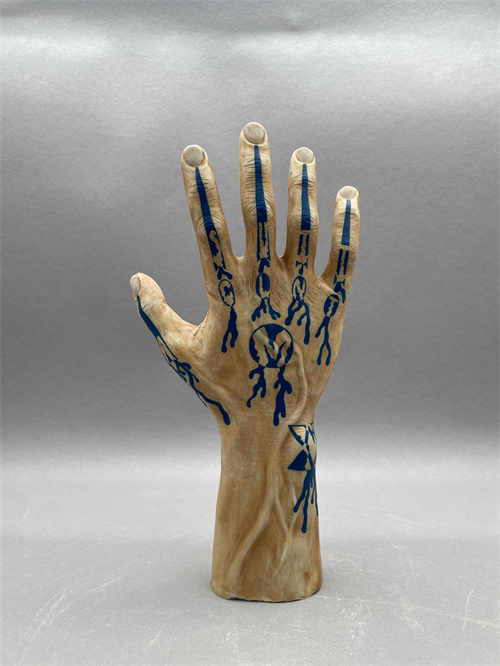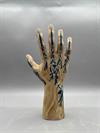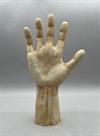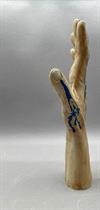Showing entries for
Entered Information
| Student Name: | Noah M |
| Grade: | 11 |
| Title: | Assimilation |
| Description: | After centuries of independence, the Ryukyu Kingdom, including Okinawa and stretching from Taiwan to the Southern island of Japan, Kyushu, was dissolved and absorbed into Japan. In this process, Okinawan people were forced to assimilate into mainland Japanese culture and thus abandon many of their traditions and even their native language. One custom that faded as a result of this assimilation was the female Okinawan tattoo called hajichi, banned by the Meiji government in 1899. Hajichi were associated with pride in being a woman and their rite of passage. My hand sculpture incorporates these hajichi tattoos. Within the tattoos are the letters that spell out “masculinity.” There are three parts to this. First, so often is masculinity defined by what it is not. Many men seem afraid of coming off as feminine; within this comes the dissociation from anything that carries a “feminine connotation.” As the letters for “masculinity” are negative spaces defined within the traditionally female tattoo, it displays how masculinity is defined by being what femininity is not. Additionally, the letters of “masculinity” begin as rigid block letters but start to curve and become fluid as they spill out of the confines of the tattoo. This is meant to show the fluidity of terms like “masculinity” and “femininity” and how many different people define their masculinity (or femininity) in their own personal way. Finally, assimilation. Just as the Okinawan people were assimilated into a larger Japanese culture and thus forced to renounce some of their unique customs, many men are forced to assimilate into a broad, societal definition of “masculinity” and consequently forced to abandon their unique, possibly “feminine” traits in a pursuit to fit in. The actual hand sculpture is meant to seem more “masculine” with wide, rough hands and palms, wrinkles, and veins. This is yet another contrast with the hajichi as they are a traditionally female tattoo. The fingers are arched back in an expression of pain and repulsion as if trying to display resistance to assimilation and losing their unique qualities. |
| Dimensions: | (L)2.4 x (W)5.25 x (H)10.5 (Inches) |
| Weight: | 5 Lbs. |
| School: | Chadwick School - Palos Verdes Peninsula, CA |
| Teacher: | Annie Webster |
| Exhibition: | The 27th Annual National K-12 Ceramic Exhibition |
Recognition
No awards given
Additional Work Info
Entry Photos


Front Photo

Back Photo

Left Photo

Right Photo

Top Photo
